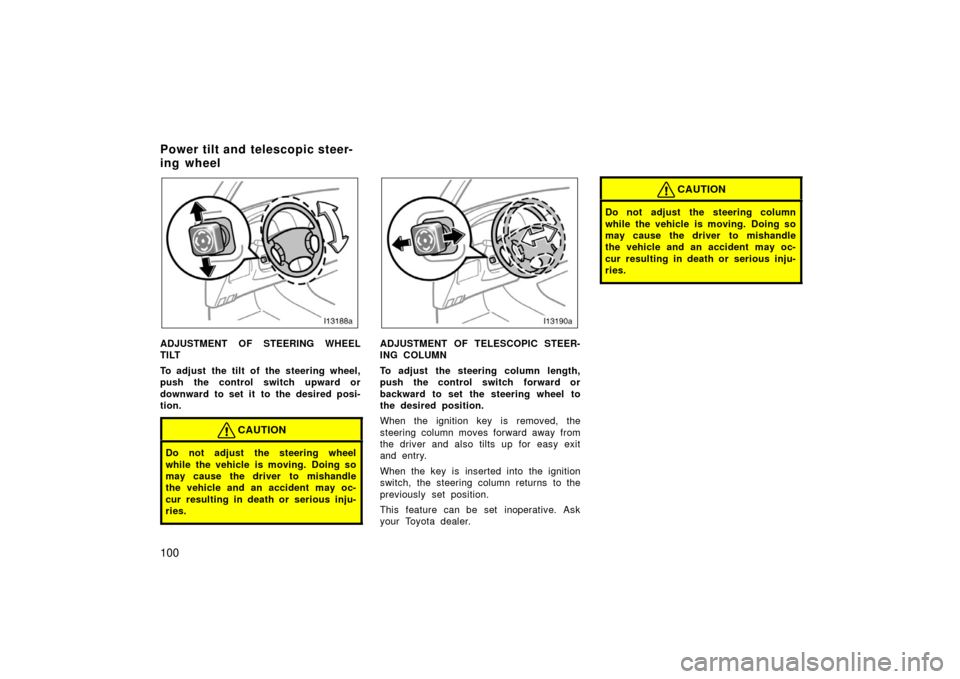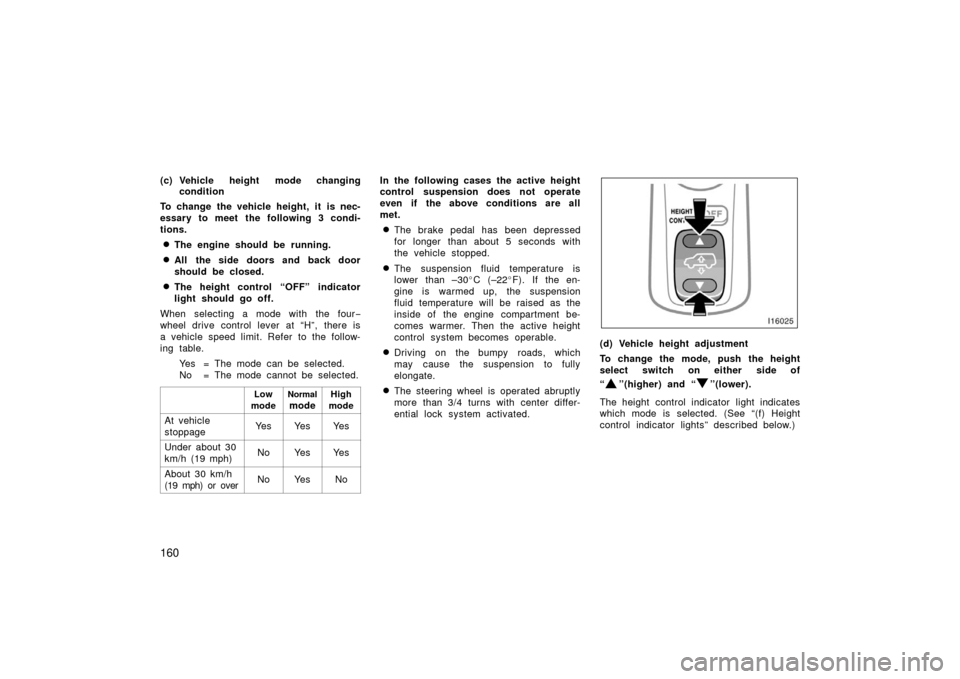Page 110 of 364

100
ADJUSTMENT OF STEERING WHEEL
TILT
To adjust the tilt of the steering wheel,
push the control switch upward or
downward to set it to the desired posi-
tion.
CAUTION
Do not adjust the steering wheel
while the vehicle is moving. Doing so
may cause the driver to mishandle
the vehicle and an accident may oc-
cur resulting in death or serious inju-
ries.
ADJUSTMENT OF TELESCOPIC STEER-
ING COLUMN
To adjust the steering column length,
push the control switch forward or
backward to set the steering wheel to
the desired position.
When the ignition key is removed, the
steering column moves forward away from
the driver and also tilts up for easy exit
and entry.
When the key is inserted into the ignition
switch, the steering column returns to the
previously set position.
This feature can be set inoperative. Ask
your Toyota dealer.
CAUTION
Do not adjust the steering column
while the vehicle is moving. Doing so
may cause the driver to mishandle
the vehicle and an accident may oc-
cur resulting in death or serious inju-
ries.
Power tilt and telescopic steer-
ing wheel
Page 159 of 364

149
Stop your vehicle at a safe place as soon
as possible and check that the tire infla-
tion pressure is as specified on the tire
and loading information label. If the low
tire pressure warning light comes on even
after tire inflation pressure adjustment, it
is probable that you have a flat tire. If
the tire goes flat, change to the spare
tire. (See page 275.)
The spare tire is not equipped with the
tire pressure sensor. So, the low tire
pressure warning light remains on even if
the spare tire is mounted.
The light goes off a few minutes after air
is put into the deflated tire.CAUTION
If the low tire pressure warning light
comes on, observe the following in-
structions:
�Decelerate as soon as possible to
the most appropriate speed that
conditions permit.
�Avoid abrupt steering wheel maneu-
vering and braking. If the vehicle
tires deteriorate, you could lose
control of the steering wheel or the
brakes, causing death or serious in-
jury.
�The warning system may not acti-
vate immediately if bursts or sud-
den air leakage should occur.
Each tire, including the spare (if pro-
vided), should be checked monthly
when cold and inflated to the inflation
pressure recommended by the vehicle
manufacture on the vehicle placard or
tire inflation pressure label. (If your
vehicle has tires of a different size
than the size indicated on the vehicle
placard or tire inflation pressure la-
bel, you should consult the appropri-
ate section of the owner ’s manual to
determine the proper tire inflation
pressure.) When the low tire pressure
telltale is illuminated, one or more of
your tires is significantly under�in-
flated. You should stop and check
your tires as soon as possible, and
inflate them to the proper pressure as
indicated on the vehicle’s tire infor-
mation placard. Driving on a signifi-
cantly under�inflated tire causes the
tire to overheat and can lead to tire
failure. Under�inflation also reduces
fuel efficiency and tire tread life, and
may affect the vehicle’s handling and
stopping ability.
Page 170 of 364

160
(c) Vehicle height mode changingcondition
To change the vehicle height, it is nec-
essary to meet the following 3 condi-
tions.
�The engine should be running.
�All the side doors and back door
should be closed.
�The height control “OFF” indicator
light should go off.
When selecting a mode with the four −
wheel drive control lever at “H”, there is
a vehicle speed limit. Refer to the follow-
ing table.
Yes = The mode can be selected.
No = The mode cannot be selected.
Low
modeNormal
mode
High
mode
At vehicle
stoppageYe sYe sYe s
Under about 30
km/h (19 mph)NoYe sYe s
About 30 km/h
(19 mph) or overNoYe sNo
In the following cases the active height
control suspension does not operate
even if the above conditions are all
met.
�The brake pedal has been depressed
for longer than about 5 seconds with
the vehicle stopped.
�The suspension fluid temperature is
lower than –30 �C (–22 �F). If the en-
gine is warmed up, the suspension
fluid temperature will be raised as the
inside of the engine compartment be-
comes warmer. Then the active height
control system becomes operable.
�Driving on the bumpy roads, which
may cause the suspension to fully
elongate.
�The steering wheel is operated abruptly
more than 3/4 turns with center differ-
ential lock system activated.
(d) Vehicle height adjustment
To change the mode, push the height
select switch on either side of
“
”(higher) and “”(lower).
The height control indicator light indicates
which mode is selected. (See “(f) Height
control indicator lights” described below.)
Page 353 of 364
343
BRAKES
Minimum pedal clearance when depressed
with the force of 490 N (50 kgf, 110 lbf)
with the engine running, mm (in.): 116 (4.6)
Pedal free play, mm (in.): 1 – 6 (0.04 – 0.24)
Pad wear limit, mm (in.): 1.0 (0.04)
Lining wear limit, mm (in.): 1.0 (0.04)
Parking brake adjustment when pulled with
the force of 196 N (20 kgf, 44 lbf): 4 – 6 clicks
Fluid type: SAE J1703 or FMVSS No.116 DOT 3
STEERING
Wheel free play: Less than 40 mm (1.6 in.)
Power steering fluid type: Automatic transmission fluid DEXRON
II
or III